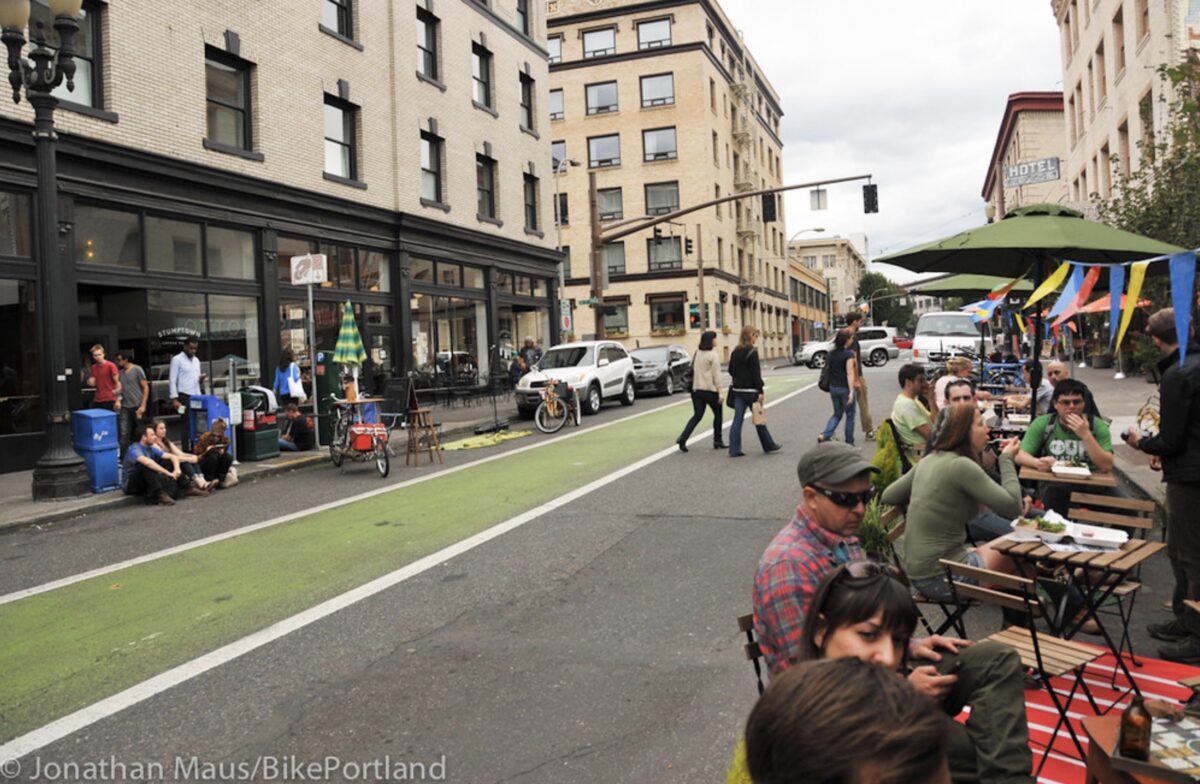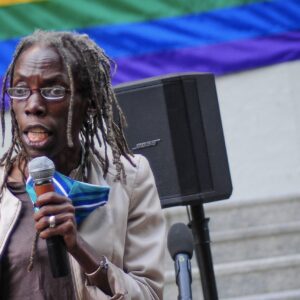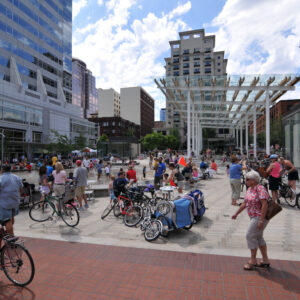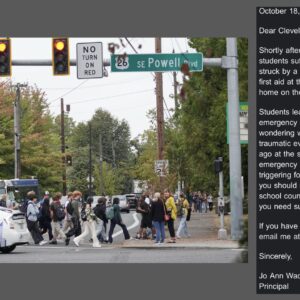
“I believe life will be radically different post-Covid and our planning should reflect our new reality.”
— Jo Ann Hardesty, city commissioner
At a city council work session Thursday, Portland Mayor Ted Wheeler and the four other commissioners had an informal and wide-ranging discussion about how to respond to the multiple crises facing our city. During the meeting, Commissioner Jo Ann Hardesty described how she wants to use her leadership of the transportation bureau to kickstart the local economy and face the climate crisis. Hardesty called it a vision for “smart transit”.
The work session was led by Dr. Markisha Smith from the Portland Office of Equity and Human Rights. Each commissioner was asked to share their opinion about the most urgent issues council should focus on in the next 12-18 months.
The first thing Hardesty mentioned was her vision for more carfree streets we reported on earlier this month. Hardesty elaborated on that idea (first shared her policy director Derek Bradley at a Bicycle Advisory Committee January 12th), but she didn’t stop there.
About one hour and 15 minutes into the two-hour session (you can watch it here), Hardesty laid out four transportation-related goals.
Advertisement
She tied a vision for carfree streets downtown to the climate crisis, economic rebirth and changing behaviors related to the Covid pandemic:

(Photo: J. Maus/BikePortland)
“When I think about smart transit I think about, as we are attempting to reach our climate goals, are there opportunities to support small restaurants across the city by closing off some streets to auto traffic? Is it possible when we are in rebuild mode coming out of Covid, to really think about what would a carfree downtown look like? I say this because I think that there is this misperception that one day we’re going to go back to business as usual and that Covid will be behind us, and we’re going to flip the switch and life will be as it was prior to Covid. I think that there’s a lot of people that believe that and I am not one of them. I believe life will be radically different post-Covid, and our planning should reflect our new reality… Is there an opportunity to create international districts in different parts of the city that people can access for food and goods and services that are not tied to people getting into automobiles?”
Hardesty then mentioned her desire to boost electric vehicle access:
“I also want to think about how we create opportunities for electric vehicle infrastructure in different parts of the city so that we can ensure that BIPOC community members have access to both building it and actually being able to take advantage of using it.”
Her next two goals were related to funding. The first was about federal funds:
“I want to make sure we are identifying federal resources that traditionally have been all about freeway expansions. I’m looking for federal resources to support a climate resilient transportation department that is really focused on green issues as compared to freeway expansions like we’re so accustomed to.”
The second was the concern that PBOT’s budget is closely tied to driving and there’s still no substitute to gas taxes and parking-related revenues — both of which were trending down before the pandemic hit:
“[I am interested in] trying to identify new funding opportunities to create a smart transit system for PBOT that is not dependent on people driving automobiles, and not dependent on people parking at parking garages [PBOT owns and operates several of them downtown]. We are facing a $40 million budget deficit because normal funding mechanisms have been impacted by A) Covid and B) should be impacted by our climate justice and resiliency goals.”
The facilitator then asked other commissioners to respond.
Advertisement
Commissioner Mingus Mapps said, “I generally support this vision. I think it’s innovative and I’m happy to work with a lot of these things.”
Commissioner Carmen Rubio said, “I also support it. It’s in line with a lot of our goals, particularly around equity.”
Commissioner Dan Ryan was much less enthusiastic: “It felt very connected to the climate crisis, even though it was stated as transportation. But that’s what I kept hearing. It’s not in my top three or four, but I respect what I just heard.”
Mayor Wheeler responded with, “I appreciated it. It sounded more like the answer to a broader question. It sounded tactical. I think it is in alignment with our stated goals around climate action and transportation equity. But I would see that as one of multiple strategies that are fulfilling the larger objective.” Then he added, “I want to say this: I actually love innovative and visionary thinking and I appreciate that. It’s a good vision.”
With new leadership in City Hall and multiple crises facing Portland, now is a great time for a new transportation vision and more urgency on the topic in general — something Portland hasn’t for years. Hardesty seems to understand the opportunity and appears to be unafraid to try and meet it. As she laid out her idea to use streets as gathering places in a way that would help our economy rebound in a Covid-safe way, Hardesty said, “That’s one of the exciting things about having transportation at this moment.”
— Jonathan Maus: (503) 706-8804, @jonathan_maus on Twitter and jonathan@bikeportland.org
— Get our headlines delivered to your inbox.
— Support this independent community media outlet with a one-time contribution or monthly subscription.






Thanks for reading.
BikePortland has served this community with independent community journalism since 2005. We rely on subscriptions from readers like you to survive. Your financial support is vital in keeping this valuable resource alive and well.
Please subscribe today to strengthen and expand our work.
Not sure I understand what Ted said.
Neither does he. He’s just mad that JoAnn pulled her support for his reelection campaign after he demonstrated backstabbing/ being two faced. He’s being petty.
“Sounded tactical” … wtf.
Someone should educate Dan Ryan that talking about climate change and transportation together is critically important because transportation accounts for 40% (and rising!) of Oregon’s GHG emissions. You literally cannot talk about them separately.
I’m not sure if he genuinely doesn’t grasp the connection between transportation and climate change (which, as you state, is massive and unavoidably obvious) or if he’s just playing incredibly dumb. Either is appalling.
If by EV infrastructure Comm. Hardesty means access to privately-owned chargers, then this is not equitable access at all. Currently, on a MPGe basis it costs significantly more to charge an inexpensive EV at publicly-available chargers than it does to fill up the gas tank of a cheaper car/hybrid. And when one assesses the time involved in charging, it is even more expensive for lower-income folk from a quality of life perspective. Therefore, EVs only make sense for renters and lower-income people if chargers are heavily-subsidized (e.g. fees are close to the current residential costs of electricity) and chargers are located nearby their homes. Without some sort of mandate that requires landlords to build new chargers (or update wiring systems so that jury-rigged L1 chargers can be used overnight), there is an intractable systemic barrier for most lower-income people.
I have become convinced that EVs are the most likely path to decarbonization of transportation but that this achingly slow transition will only worsen transportation equity. I wish I did not believe this, for many reasons.
It will be even more marked with newer apartments built without onsite parking, making it impossible for renters to charge their own vehicles at their residences, even if we compel landlords to provide charging infrastructure.
Counterpoint: There are plenty homeowner-claimed parking spaces in neighboring RIP exclusionary zones that could be permanently allocated to renter EV charging.
Sure… if we lined the streets with sort of public charging stations that you were complaining about, and people were willing to travel to those neighborhoods to charge their cars, a burden you were also complaining about. (I believe you called these problems “an intractable systemic barrier for most lower-income people.”)
All this is assuming, of course, that local residents didn’t use them for charging their own vehicles.
only a Portland landlord could read “permanently allocated to renter EV charging” and erase renters.
Why couldn’t “local residents” be renters? My neighborhood is 50% renters, who you apparently just “erased”.
the word “renter” excludes renters? lovely cognitive dissonance, kitty.
(landlords know that our housing system is dehumanizing and immoral so they hide from their guilt in a fog of cognitive dissonance.)
I was referring to your assumption that “local residents” did not include renters. But whatever. After proposing a solution that was comprised of elements you earlier wrote were “intractable”, it is hard to take your charges of cognitive dissonance seriously.
Could we please keep the conversation in the realm of ideas, rather than rely on personal attacks?
“proposing a solution that was comprised of elements you earlier wrote were “intractable””
strawman 1
“your assumption that “local residents” did not include renters”
strawman 2
i still think it would be amusing if residential spaces formerly occupied by homeowner cars were exclusively reserved for lower-income EV charging (a la living cully’s demo). i realize that my scenario is likely impossible in this classist and racist city but it’s amusing how it raised the hackles of a landlord kitty.
There’s like 25 bills on the OR transport committee on EV charging. The only way to fight the inequities is to make sure we get it better (it won’t ever be perfect), but if we take an active role in the next six months in Salem, we can make a difference. They are listening for any and all ideas to reduce carbon in transport, at least the sincere ones like Rep. Powers and Bynum. RESPECT!!
“They are listening for any and all ideas to reduce carbon in transport…”
I could not disagree more strongly but will leave it at that.
Many new developments will include some on-site parking with chargers, because some tenants will want the option.
Just thinking out loud here, but it seems we’re caught in the dominant paradigm that the “cars” of the future (EVs or whatever) will be owned by individuals and driven as SOVs? What if instead only EVs were allowed downtown, and only EVs that had permits issued by the city, and private owners could not access those permits. Instead, EVs operated out of fleet garages, where they were kept charged. Perhaps even driverless vehicles. If you really “needed” to get downtown by car, you would use an app and request one of these vehicles to pick you up.
I believe that when self-driving cars arrive in full-force, the economics will strongly favor fleet vehicles and that individual ownership will fall dramatically. I expect that for most trips (including those currently made by bus), driverless Uber will become the dominant mode.
I remember a conversation with Chris Smith in 2015 (at the now-closed Ford) where he insisted that fully self-driving EVs would arrive in force by the mid 20s. I heard similarly absurd narratives from city and nonprofit staff. And here we are 5+ years later with nothing to show for tech-capitalist hopium other than Google’s insanely-expensive fossil-fuel-burning vans running on fully-scanned (to the cm) routes (level 2).
Autonomous driving (level 4) is decades away and fully autonomous driving is nothing more than a pipe dream at this point (level 5).
https://news.mit.edu/2020/mit-3-questions-john-leonard-future-of-autonomous-vehicles-0804
We’ll see. Tesla is rolling out their system in the coming months.
But even if they don’t arrive until the 2030s, my analysis still holds.
Maybe we can have the stations charge at different speeds determinate upon individual wealth.
This is fantastic! It is refreshing for someone to have clear short term goals rooted in a big vision.
Again. Joann Hardesty demonstrating Leadership and Vision. Big thanks to Mingus and to Carmen for jumping right in with great support. Dan Ryan continues to let me down. And Ted is a sad failure.
I believe in you Joanne.
I tend to agree. Joann seems to be the only one with vision right now, although it’s probably too early to judge Mingus and Carmen yet. I think Dan really has to step up to the plate a bit more. I also recognize that his home has been targeted repeatedly by vandals which is an awful introduction to his role on the council regardless of his policy positions.
I think Joann is more into division than leadership. She talks a lot but I haven’t seen anything of value produced. Her police budget reduction has been a disaster. Cutting funds without a replacement in place was a recipe for the big mess we have now. If you want the Portland
Street Response to take over some of the low level 911 calls then have it in place and ready to go before cutting funding to public safety in order to “punish” the police. It is now the community that is being punished by her actions. I hope this is her last term in office.
Your response to Hardesty’s proposal proves her point about how her vision is different from that of people who just want things to go back to how they were before. That’s not happening.
I’m not sure I understand this comment. Christian is saying that cutting the police without an alternative in place will incur a cost on the public in the form of increased crime. Are you saying that Hardesty’s vision is that we should just accept that outcome?
Anyone who finds the increase in shootings in E Portland and dramatic upturn of less violent crime elsewhere even remotely acceptable does not share my vision for this city. If that is Hardesty’s position, it is very unlikely she will enjoy a second term.
It’s exciting to see the discussion about car-free streets.
Ironically and coincidentally, while the photo shows SW Harvey Milk, converting car space to dining space, etc. it aims directly at a restaurant in the background associated with the judge who infamously ruled that bike lanes disappear in every intersection, meaning right hooks are the bike rider’s fault.
Ummm. Leadership from Hardesty(or Wheeler of any of them)??, this city looks like a garbage dump, boarded up windows everywhere because someone breaks them if they are not….shootings becoming a daily event. Traffic deaths at all time levels.
She is a Fail in everyway
You should leave your house more often dwk. That is not my impression of Portland in this moment at all. Yes there are some things that bum me out about our city right now, but it’s still beautiful and people are good and there is a lot of cool stuff around!
I bike 20 miles a day around town. Past probably 2000 homeless people? My neighborhood (Hollywood) is boarded up because vandals broke all the windows (not one person charged in that event). The city needs entirely new leadership.
Ever take a bike ride down 33rd to Marine drive? That is allowed in the US?
The city is looking like a third world country.
I think you’re both right. Still plenty of good people and cool stuff (that we can’t readily visit right now), but also a huge amount of destruction, lawlessness, and civic retreat. The city is by far in the worst shape I’ve ever seen. By far.
The only people who think this city is fine right now are very privileged….the rest of us are just tired.. tired of garbage, tired of 100 people creating national news every day because local officials will not stop them destroying local businesses for no reason.
Elected people like Hardesty say and do nothing.
BP is lucky it does not have a store front.
Jonathan,
That was a little testy. You might need to call in the moderator on that post. 🙂
Turn the screws on the old guard: First Principles
1. The only priority, pretty much anywhere on Earth, is to reduce emissions by >50% by 2030. True for Oregon. True for PDX Metro. True for PBOT.
Ask council members for their plans. Watch them squirm. Fire them.
Hardesty has hers.
Not in NC nor in much of the rest of the USA. Our community is just a year away from completing a full beltway that took $1 Billion and 20 years to build, something that is not only unsustainable but totally unaffordable too for this small city, partly using sales taxes on food. And of course our “liberal” and nearly all-female city council wants to build more highways for purposes of economic development, reduce crime, vision zero, etc etc etc. They are utterly clueless, but that’s OK, they are all Democrats…
I love that Hardesty is taking an immediate interest in PBOT. No surprise Dan Ryan pew pewed her answer, I’ve never regretted voting for someone quicker than I regretted voting for Dan.
delete..:)
I SO agree.
Can we please vote out of all Teds and Ted look alikes?
Can we please vote out JoAnn?
It’s unfortunate that she doesn’t understand that this plan requires a LOT of private investment which doesn’t occur in city’s where shit-bags rule the day.
RESIST Hardesty.
My neighbors, all respectable granola & sandals doctor an accountant couple, have a Tesla and a Leaf + a pick-up with a transfer tank in the back. 2 Solar panels on the roof and 2 noisy army surplus diesel generators, using untaxed red diesel or #1 diesel (basically bunker oil for ships and trains) to charge said electric cars. 4h of noise and pollution every day. The dude is loaded but a self-professed cheapskate. They’re doing this to save a buck, not the planet. Yay!
This can’t possibly be cheaper than using normal gas vehicles. The efficiency lost from running diesel generators to charge electric cars is huge. Start with the inefficiency of the ICE for the generator, and then the losses from converting to DC and losses in battery charging… where is this? Somewhere rural and off the grid?
I wondered about that too, and also whether they’re using hobby-brewed biodiesel, with cost not their primary motive.
I love the Hardesty is even talking about doing something different. However, she is ignoring one of the largest contributors to speeding downtown which are raceways(I mean one ways). Get rid of those, and things slow down and people actually slow to smell the restaurants they are speeding by.
Hey Joanne – 3 of 4 citizens have, for a long time, consistently voted by their choices of transportation – not bikes and public transit; they don’t work for them. PBOT has been choking traffic and increasing idle time and air pollution. Ridership has stayed flat or gone down. That will not change. Get PBOT to fix potholes and pave roads east of 82nd THAT would address your equity goals.
Your vision sounds like standard PBOT idiocy – sadly, you seem to have swallowed too much koolaid.
text pasted into wrong article, please disregard
Thanks!
“I believe life will be radically different post-Covid, and our planning should reflect our new reality” goes far beyond some car-free streets.
Much of Portland’s and Metro’s transportation system and planning is based on a central city employment core, large volumes of commuters traveling into that central core every morning and back home every afternoon, high demand for housing close-in to that center, and high demand for offices in that center. MAX is designed for that purpose, with all lines in a spoke pattern converging on the downtown hub. Trimet bus routes similarly emphasize moving passengers from all over city in/out of downtown. Bike infrastructure also emphasizes getting to and around in the central core. Our urban planning is based on using density to accommodate the demand for housing close to downtown and close to transit that takes people downtown.
A substantial portion of jobs are no longer being done from those central city offices. They are being done from living rooms and bedrooms all over the city, and both employers and employees are finding the new remote, distributed, working from home arrangement to be better than the pre-Covid model. Employers are shedding unneeded office space, employees are appreciating the 15 second commute. The next step is employers looking to further reduce costs by moving their workforce’s notional “location” to lower-tax, lower-cost regions, and employees looking for housing with extra rooms for their home offices, and benefits that they previously gave up for the shorter commute – more greenery, more open space, better schools, less of the negatives of urban living. The migration to the suburbs or just to further-out neighborhoods is very real, just as is, on a more macro scale, the migration from high cost states to low cost states.
Is “everyone” moving from their small close-in apartment to a 3 bedroom house seven or twenty miles from downtown, or from their downtown office to a WFH office, or from Portland to Vancouver, Hillsboro, Austin, Boise, Raleigh, etc? Of course not – to start with, many jobs can’t be WFH’d. But just a 10 percent change in demand patterns will upend existing economic and planning models.
What does this mean for PBOT and the rest of our transportation agencies and systems? Well, transit ridership is going to be lower, especially on the traditional commute routes, while there will be demand for trips that neither start nor end downtown – which MAX and Trimet currently don’t serve well. Commuter car traffic in/out of the downtown core is going to be lower, and a higher percent of car trips will be on diffuse routes, to/from local retail/entertainment districts or to visit friends and attractions distributed all over the four county region. More trips will be at the convenience of the individual – instead of rushing 5 miles downtown for the 8 am staff meeting, think finishing the 8 am Zoom staff meeting then heading to the breakfast joint a mile away, or if the weather is foul then maybe not.
This is likely a great thing for bikes. The bike – or scooter, e-bike, e-trike, etc – maybe wasn’t so attractive for the daily 5 mile trip in the early morning dark and rain to sit soggy in the 8 am staff meeting. But it looks more attractive for the quick trip to the coffee and danish on a clear day.
This is probably a mixed bag for cars – while flexible point to point transport on routes that transit doesn’t serve will still be in demand, if you’re not using the car to commute every day, paying for a car share or ride share every couple of days starts looking a lot better.
This is very likely a bad thing for transit, especially fixed-rail that relies on high density of riders between an immovable set of high cost hubs to be economically viable. Buses can, I think, be rerouted to serve more diffuse, occasional, and spread out travel patterns, but smaller neighborhood bus routes may be better suited than high cost, fixed route “bus rapid transit” lines.
Anyway, I’d like to hear how PBOT is planning for this “new normal”. Some car-free streets in the downtown core sound like a good idea – they always were a good idea, and should be easier to achieve in a depopulated downtown desperate for re-invention. But the bureau has much larger changes to assess and make.
This survey suggests the potential changes in Portland’s work travel patterns.
https://www.pwc.com/us/en/library/covid-19/us-remote-work-survey.html
Suppose 5-10% of downtown offices close entirely or almost entirely as their workforce go to all or almost all remote, 10-20% of downtown offices are signficantly downsized to meeting/collaboration facilities and some hot desks, and 20-30% of downtown offices stay as they are but the employees come in 2 fewer days/week. That would imply a 23-42% decline in downtown officeworker commuter traffic and downtown daytime officeworker population. A related decline in downtown serviceworker employment would follow, as fewer lunch spots and retail businesses would exist. That would be a huge change in transportation and downtown land use patterns.
Then suppose 20% of those officeworkers and former officeworkers reconsider their housing choices, looking for more space for their home offices, better schools, more open spaces, etc, while caring less or not at all about a short commute to downtown. Maybe they join those moving from small close-in apartments to larger apartments or houses farther out, or move to Hillsboro or Camas, or to Boise or Hood River. That would be another huge change in transportation and city wide land use patterns.
Would MAX survive in a new normal with 20-40% less commuter passengers?
Would Powell still need its current 18 lanes (exaggerating of course but it feels like that sometimes)?
Would a Sandy streetcar line still make sense?
Would the MAX line to Tigard still make sense?
Would we need the 405? At the same time, would we need the extremely expensive land reclaimation that removing the 405 would be?
Would TriMet need as many east-west routes in the east and west of the city, or as many north-south routes in the north and south of the city?
I hope PBOT and other city bureaus are not doggedly forging ahead on their pre-2020 plans and project lists, without stopping to figure out what the new normal is actually going to look like.
Great article with very valid points. The Central City accounts for PBOT’s largest expenditure for maintenance and the CCIM plan ($64 million) was proposed pre-covid. I would think it prudent to take WFH issues into account moving forward with transportation planning and funding.
As an East Portland resident living on a street where 6 houses have sold in the last 9 months to younger folks with the capacity and a plan to work from home, PBOT will absolutely need to look at WFH situations to determine where and how our tax dollars will be spent in the future. Tele-commuting has seen the largest uptick in commuting numbers even before Covid-19 while commuting by bike numbers have remained flat for years.
Let’s give people infrastructure to move around their neighborhoods and get their children to school safely without using a large vehicle. That would seem to me to be smart transportation planning.
I’m curious if you know where the folks that lived in those houses got “pushed” to?
Not sure if they were buried, or cremated. One fellow moved to Colorado.